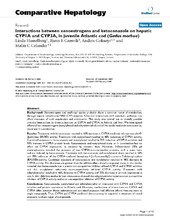| dc.contributor.author | Hasselberg, Linda | eng |
| dc.contributor.author | Grøsvik, Bjørn Einar | eng |
| dc.contributor.author | Goksøyr, Anders | eng |
| dc.contributor.author | Celander, Malin C. | eng |
| dc.date.accessioned | 2014-09-12T07:27:46Z | |
| dc.date.available | 2014-09-12T07:27:46Z | |
| dc.date.issued | 2005-02-08 | eng |
| dc.identifier.issn | 1476-5926 | en_US |
| dc.identifier.uri | https://hdl.handle.net/1956/8457 | |
| dc.description.abstract | Background: Xenoestrogens and antifungal azoles probably share a common route of metabolism, through hepatic cytochrome P450 (CYP) enzymes. Chemical interactions with metabolic pathways may affect clearance of both xenobiotics and endobiotics. This study was carried out to identify possible chemical interactions by those substances on CYP1A and CYP3A, in Atlantic cod liver. We investigated effects of two xenoestrogens (nonylphenol and ethynylestradiol) and of the model imidazole ketoconazole, alone and in combination. Results: Treatment with ketoconazole resulted in 60% increase in CYP1A-mediated ethoxyresorufin-O-deethylase (EROD) activity. Treatment with nonylphenol resulted in 40% reduction of CYP1A activity. Combined exposure to ketoconazole and nonylphenol resulted in 70% induction of CYP1A activities and 93% increase in CYP1A protein levels. Ketoconazole and nonylphenol alone or in combination had no effect on CYP3A expression, as analyzed by western blots. However, 2-dimensional (2D) gel electrophoresis revealed the presence of two CYP3A-immunoreactive proteins, with a more basic isoform induced by ketoconazole. Treatment with ketoconazole and nonylphenol alone resulted in 54% and 35% reduction of the CYP3A-mediated benzyloxy-4-[trifluoromethyl]-coumarin-O-debenzyloxylase (BFCOD) activity. Combined exposure of ketoconazole and nonylphe nol resulted in 98% decrease in CYP3A activity. This decrease was greater than the additive effect of each compound alone. In vitro studies revealed that ketoconazole was a potent non-competitive inhibitor of both CYP1A and CYP3A activities and that nonylphenol selectively non-competitively inhibited CYP1A activity. Treatment with ethynylestradiol resulted in 46% decrease in CYP3A activity and 22% decrease in protein expression in vivo. In vitro inhibition studies in liver microsomes showed that ethynylestradiol acted as a non-competitive inhibitor of CYP1A activity and as an uncompetitive inhibitor of CYP3A activity. Conclusions: Ketoconazole, nonylphenol and ethynylestradiol all interacted with CYP1A and CYP3A activities and protein expression in Atlantic cod. However, mechanisms of interactions on CYP1A and CYP3A differ between theses substances and combined exposure had different effects than exposure to single compounds. Thus, CYP1A and CYP3A mediated clearance may be impaired in situations of mixed exposure to those types of compounds. | en_US |
| dc.language.iso | eng | eng |
| dc.publisher | BioMed Central | en_US |
| dc.rights | Attribution CC BY | eng |
| dc.rights.uri | http://creativecommons.org/licenses/by/2.0 | eng |
| dc.title | Interactions between xenoestrogens and ketoconazole on hepatic CYP1A and CYP3A, in juvenile Atlantic cod (Gadus morhua) | en_US |
| dc.type | Peer reviewed | |
| dc.type | Journal article | |
| dc.date.updated | 2013-08-28T17:17:50Z | |
| dc.description.version | Peer Reviewed | |
| dc.description.version | publishedVersion | en_US |
| dc.rights.holder | Linda Hasselberg et al.; licensee BioMed Central Ltd. | en_US |
| dc.rights.holder | Copyright 2005 Hasselberg et al; licensee BioMed Central Ltd. | en_US |
| dc.source.articlenumber | 2 | |
| dc.identifier.doi | https://doi.org/10.1186/1476-5926-4-2 | |
| dc.identifier.cristin | 420294 | |
| dc.source.journal | Comparative Hepatology | |
| dc.source.40 | 4 | |

